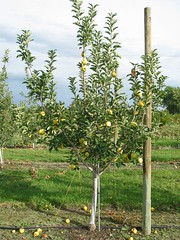Pomological researchers have assessed other approaches to determining potential yield. Since planting density works together with per-tree yield to determine productivity per acre, researchers have used canopy dimensions to estimate planting density and then estimated potential yield per acre. This approach is perfect if the trees used to measure yield and canopy size are not contained by any pruning. Once the canopy is manipulated, and particularly if it is manipulated differently for trees of different sizes, potential yield per acre …
How Apple Tree Productivity Is Measured
The simplest approach to measuring productivity is to assess yield on a per-tree basis; it is straightforward and easy to understand. The problem comes when comparing trees of different sizes. For instance, comparing the productivity of apple trees on M.9 NAKBT337 and those on G.30 on a per-tree basis would be meaningless. The size of trees on M.9 NAKBT337 would allow much greater planting densities than would that of trees on G.30. Therefore, trees on M.9 NAKBT337 could have a …
Apple Rootstock Influence on Precocity
One of the factors to consider when choosing a rootstock is its influence on the ability to induce fruitfulness — defined by horticulturists as precocity. Horticulturists measure this trait in apple rootstocks by observing the length of time from planting to when the cultivar produces flowers. The trend is as the rootstock induces more dwarfing, the scion cultivar will flower earlier in the life of the orchard. For example, if a cultivar is grafted onto a dwarfing rootstock and a …
Apple Tree Productivity
In addition to training systems, soil effects, and rootstocks, productivity is one of the most important parameters when comparing apple cultivars to determine ultimate profitability. Pomologists have long struggled with the question of how best to determine productivity when comparing trees of different size, such as those encountered in rootstock evaluations.
How Apple Tree Productivity Is Measured
For more information:
W. Autio, D. Greene, and W. Lord presented a comparison of several apple rootstocks with ‘McIntosh’ as …
Winter Hardiness of Apple Rootstocks
The capacity of apple trees to survive low temperatures is influenced by the scion cultivar and the rootstock. Rootstocks vary in their low temperature tolerance. Some rootstocks cease growth earlier than others, which results in high levels of resistance to early winter freezes. In the fall, with shorter day lengths and cooler temperatures, trees start to acclimate to low temperatures at the outer tips of branches. This process of acclimation (the ability to adapt to colder temperatures) progresses toward the …
Apple Rootstock Testing and NC-140
What Is NC-140?
 NC-140 is a north central regional project, funded by the USDA, that meets the guidelines presented by the North Central Regional Association (NCRA) in Guidelines for Multistate Research Activities. This project was established, under different names, in the 1960s by a group of horticultural researchers from across the United States and Canada to evaluate horticultural uses of rootstocks. In the mid 1970s, NC-140 was officially created and focused solely on apple rootstocks.
NC-140 is a north central regional project, funded by the USDA, that meets the guidelines presented by the North Central Regional Association (NCRA) in Guidelines for Multistate Research Activities. This project was established, under different names, in the 1960s by a group of horticultural researchers from across the United States and Canada to evaluate horticultural uses of rootstocks. In the mid 1970s, NC-140 was officially created and focused solely on apple rootstocks.
Prior to these national/international projects, …
Understanding Apple Tree Size: Dwarf, Semi-Dwarf and Standard
Apple rootstocks have traditionally been divided into three groups: standard, semi-dwarf, and dwarf.
A standard size tree refers to trees growing on seedling rootstock. If trees on seedling rootstocks are not pruned to limit tree size, the trees will reach a height of about 30 feet and have a crown diameter of about 30 feet. Orchards planted before the 1960s often had only 40 trees per acre and were spaced 40 feet by 40 feet. With good pruning, standard size …
Support for Apple Trees on Dwarfing Rootstocks
Dwarf apple tree supported by single wire and conduit with wooden posts no more than 50 ft. apart within the row. Photo: Jon Clements, University of Massachusetts Amherst. |
 |
When propagated on dwarfing rootstocks, most apple cultivars will lean or fall over as they start to fruit. Trees on dwarfing rootstocks tend to produce heavy crops relative to the size of the tree, and the tree cannot support the weight of the crop. Many dwarf rootstocks also produce relatively shallow, brittle …
Apple Rootstocks and Virus Status
The virus status of a tree or rootstock simply refers to whether the plant material in question is free of known viruses. The original Malling rootstocks, such as M.7, M.26, and M.9, contained some viruses. Many viruses are latent and do not produce visible symptoms, so it is difficult to know whether a tree is infected with a virus. Most of the Malling rootstocks have been “cleaned up,” and the virus-free rootstocks carry the suffix “EMLA” (East Malling and Long …
